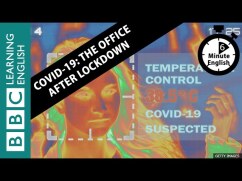the_office_after_lockdown.pdf
the_office_after_lockdown.mp3
6 Minute English
Covid-19 The office after lockdown
This is not a word-for-word transcript
Neil
Hello This is 6 Minute English from BBC Learning English I’m Neil
Sam
And I’m Sam – still working from home, as you can hear But for many, the return
to the office has begun
Neil
And to make things safe, new thermal cameras are being installed in some
workplaces They measure body temperature to screen for coronavirus
Sam
After weeks of working at home the return to the office is slowly getting
underway in a number of countries
Neil
But workplaces are having to change in this coronavirus era Lots of companies
are rushing to install technology to make offices and workplaces safer Sensors
that monitor our movements, smartphone apps that alert us if we get too close
to workmates and even devices that take our temperature could all become the
new normal – that's a phrase we hear a lot these days, meaning a previously
unfamiliar situation that has become usual and expected
Sam
In this programme we’ll take a look at how this technology works and ask if it
really is the answer we’re looking for
Neil
But first, today’s quiz question The thermal cameras I mentioned screen for
coronavirus by recording skin temperature in the area of the body which most
closely resembles the internal body temperature - but which area is that? Is it
a) the eye
b) the ear, or
c) the nose
Sam
I’ll say a) the eye
Neil
OK, Sam We’ll find out later if you were right Now, as employees slowly return
to work, tech companies are busy finding ways for them to do so safely One such
company, ‘Microshare’, is managed by Charles Paumelle He spoke to BBC World
Service programme Tech Tent to explain a possible solution
Charles Paumelle
The technology that we are offering is using Bluetooth wristbands or tags that
people are wearing within the workplace which detect proximity events When
the proximity event has been recorded its been saved by the company in case
they need to, further down the line, retrace the steps of a certain person who
has been declared as infected and inform anyone else they may have been in
contact with
Neil
One important way to control coronavirus involves contact tracing This means
that someone who tests positive for the disease informs everyone else they’ve
been in contact with Microshare’s system for this uses Bluetooth - technology
that allows computers, mobile phones and other devices to communicate with
each other without being connected by wires
Sam
Employees wear Bluetooth wristbands which register when workers come into
close proximity – how near a person is to another person
Neil
Anyone who has been close to a workmate will then know they have to take
action if that person is found to have coronavirus later down the line – in the
future
Sam
Wearing wristbands, monitoring data on smartphones and being recorded by
cameras – it all feels like quite a big invasion of privacy, doesn’t it?
Neil
It certainly does, and although some argue that such measures are necessary in
these unprecedented times, others are worried about the possible consequences
Here’s human rights lawyer, Ravi Naik, with a warning
Ravi Naik
From a human rights perspective, you have to try to ask, are you trying to use
tech for tech’s sake – is this actually going to facilitate an understanding of who
is safe to go back to work or not? And if not, what’s the necessity of this because
it’s such a significant interference with basic human rights There has to be a high
level of evidential justification to deploy this type of technology and I just don't
think it's there
Neil
Ravi questions whether these devices will actually help identify who can return to
work, or whether the technology is being used for its own sake – an expression
meaning doing something because it is interesting and enjoyable, not because
you need to
Sam
Ravi’s work as a lawyer involves finding proof that something is right or wrong If
people’s human rights are being interfered with, he thinks there has to be
evidential justification – explanation of the reasons why something is the right
thing to do, based on evidence Like the evidence from screening body
temperature…
Neil
…which bring us back to today’s quiz question Remember I asked you which part
of the body is scanned by thermal cameras to measure body temperature
Sam
And I said a) the eye
Neil
And you were absolutely right There’s a small area of the eye close to the tear
ducts which is the most accurate part of the skin for measuring body
temperature
Sam
Well, there you go
We’ve been discussing how thermal cameras and other workplace devices being
used to prevent coronavirus are becoming the new normal – a previously
unfamiliar situation that is becoming normalised
Neil
Some of these devices are wristbands with Bluetooth – technology allowing
computers and smartphones to communicate remotely without wires They can
identify work colleagues who have been in close proximity – in other words, near
to each other
Sam
That will be helpful if one of them tests positive for coronavirus further down the
line – at some point in the future
Neil
The coronavirus pandemic has caused massive changes in workplaces around the
world but some critics are concerned that contact tracing technology is being
used for its own sake - because it is interesting and enjoyable to do, rather than
being absolutely necessary
Sam
And since much of the new tech invades personal privacy it should only be
introduced with evidential justification – explanation of why it is the right thing
to do, based on evidence
Neil
Unfortunately, that’s all we’ve got time for, but remember join us again Bye for
now
Sam
Bye
VOCABULARY
the new normal
previously unfamiliar situation that has become usual or normalised
Bluetooth
technology that allows computers, mobile phones and other devices to
communicate with each other without being connected by wires
proximity
something or someone being near to another thing or person
down the line
at some point in the future
for its own sake
done because it is interesting and enjoyable, not because it is necessary
evidential justification
reasons why something is the right thing to do, based on evidence









